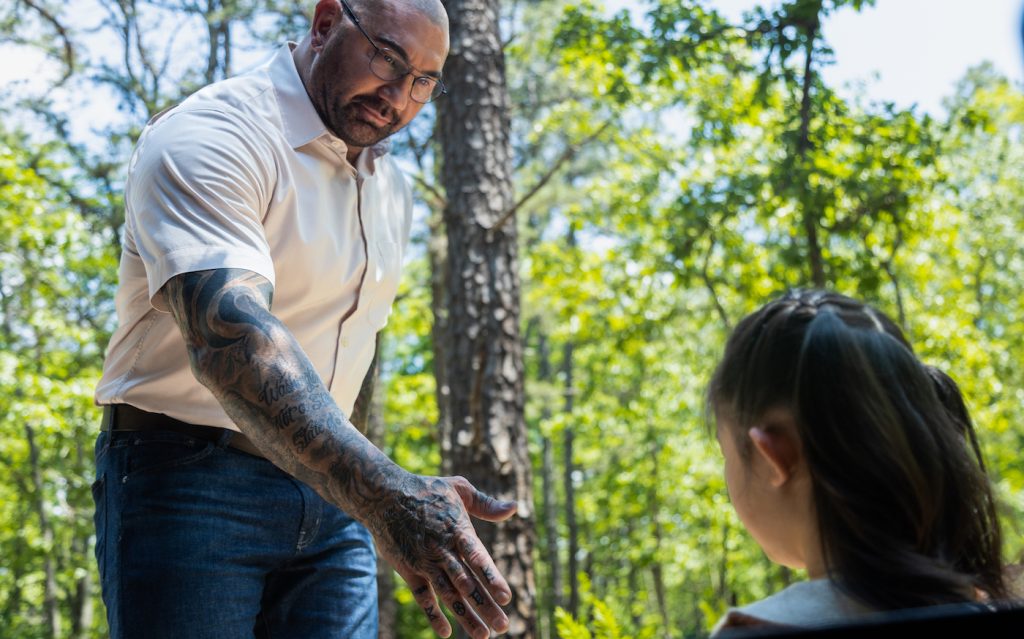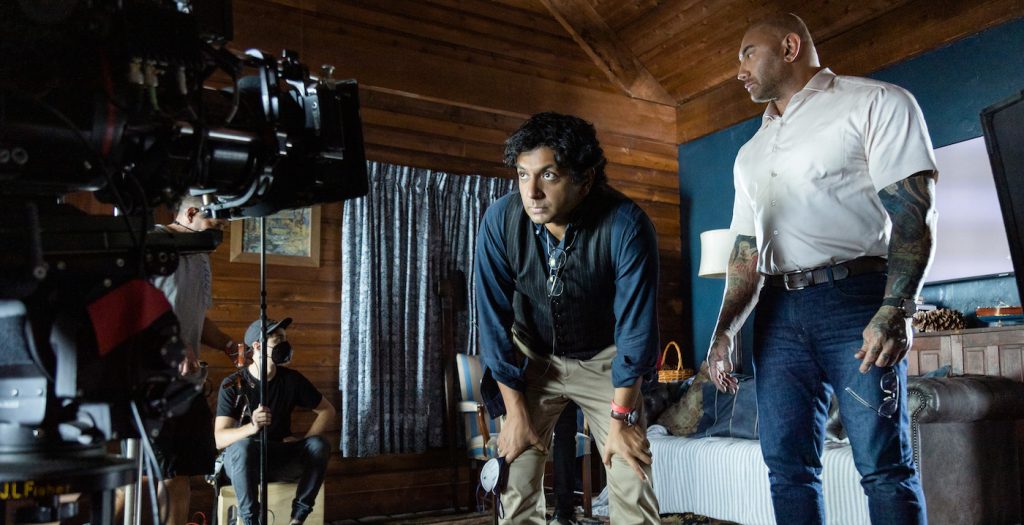“Knock at the Cabin” VFX Supervisor Tommy Tran on Creating an Unnervingly Believable Apocalypse
Seeing is believing. At least, the four prophets preaching the end of the world in M. Night Shyamalan‘s Knock at the Cabin hope that is the case. The quartet predict a series of plagues that will bring about the end of humanity unless a sacrifice is made, but will the sacrifice buy their story in time? VFX Supervisor with FuseFX Tommy Tran led work on the first global catastrophe and the eerie aftermath of all four events.
*Caution, don’t answer the door if you are afraid of spoilers*
“It was a lot of work for something that doesn’t really say, ‘Wow, visual effect,’” Tran admitted. “Everybody knows it’s a visual effect, but when you’re dealing with a spaceship or robots, there’s a little bit of suspension of disbelief that the audience has. Okay, it’s not really real, but it looks really good. But when you’re dealing with elements of nature, it’s gotta look like there’s no suspension of disbelief there. Otherwise, someone is gonna say, ‘Eh, that looks weird.’ When dealing with natural events or natural occurrences, there is no leeway for someone to say, ‘Okay, it’s not really real.’”
Leonard (Dave Bautista) and his doomsday crew first make inroads with their skeptical hostages by proving a flood they predicted comes to pass. An enormous wall of water makes landfall following massive earthquakes. Tran’s team was challenged to digitally create footage of the giant wave that looked realistic. Additionally, all of Tran’s work on Knock at the Cabin began with plates, or practical footage. The effects team worked with what they were given to paint the disasters into the peaceful scenes.
“When it comes to the billions of polygons it takes to do a wave and then multiply that by 100. The time constraints are exponential to that process,” Tran noted. “And then there’s all the other tertiary elements that go with the water wall, which is the sand, the receding water, the foam, the spray, the interaction with the spray to the actors, which 90% of them were day players. Some would run, some would walk, some would go the opposite direction. I think we ended up removing almost everybody in the background and replacing them with tiny, miniature digi-doubles that no one would have ever known that we did, but it was something that we had to do.”
Animating water is notoriously challenging. It can move as a unit but is also amorphous and constantly shifting. The physics of a giant wave overtaking a beach is extremely complicated and difficult to capture in only a few seconds. The practical footage shot for the scene ended when the wave hit the character filming the footage on their phone, leaving Tran’s team to finish the destruction of the sequence.
“A big discussion with our group was, what happens to the camera after the wave hits you? You would think it’s mayhem,” Tran recalled. “You are topsy turvy, turn after turn, swirl after swirl. We knew that we couldn’t get too crazy with the camera rotation because motion blur takes effect. We needed a sense of being in the water without too much chaos. We ended up with a certain number of camera rotations so we could still see bubbles and bodies and the murk around us. Then at the end, the camera settled, and it was a very poignant moment like a dead body floating. You’re looking up at the world as you’re dying, and you see God rays and you see silhouettes of the last vestiges of the moments of your life.”
Ultimately, fiery destruction rains down over the Earth. The serene cabin where Andrew (Ben Aldridge), Eric (Jonathan Groff), and Wen (Kristen Cui) hoped to have a peaceful, remote retreat succumbs to a forest fire. No real trees were harmed in the making of the film, but the digital trees that were burned were replicas of the original footage provided by director M. Night Shyamalan.
“We had to research where they shot, what kind of trees are prevalent there, do we have those trees in our asset library? We didn’t, so we had to make trees that were of that species around the cabin,” Tran explained.
Wind and water did appear in the filmed sequence, but they weren’t always working in tandem. The digital team had to reset the canvas, erasing any contradictory elements.
“The leaves are kind of blowing to the left and for some reason, one of their rain machines was blowing to the right,” Tran recalled. “If we have leaves moving left and practical rain moving right, we had to get rid of all the practical rain and add CG rain to match.”
The woods around the cabin were gorgeous, but dense. The VFX artists had the tedious task of erasing the trees that would be affected by the fire, particularly one that falls on the cabin. Once removed, they then built digital replicas to be able to manipulate the burning and crashing that the director called for.

“There are a lot of leaves in the forest,” Tran laughed. “We actually removed trees to get full control of the tree. The tree that we made exactly resembled the tree that we removed. At some point we couldn’t tell what tree was what. So, it took a lot of time to clean it out so that we can have full control over the wind direction where the smoke blew, because it was a full location shoot and not full digital environment with blue screens or anything like that. It was a time challenge to remove trees and get the wind and rain to cooperate.”
Wide scale and very personal horrors come to pass before the apocalypse is averted. When peace finally resumes, the survivors are left to marvel at the devastation, and process whether they truly had any role in it. Wen and her father drive into town in solitude where they find other shellshocked witnesses to the near end of humanity.
“What we got was a plate of the actors driving with no rain,” Tran explained. “Midafternoon, just driving down that street. The sides of the street were populated with buildings and houses and street wires. Then we took that, and we erased everything, keeping the form language of the street. We removed all the houses, painted out all the street wires, removed the sky.”
The somber drive strikes a very specific tone that is all thanks to the visual effects that manipulate an otherwise typical car ride. The VFX team painted in what the characters were seeing, but they also capture the mood of the moment. Though silent, the audience is given all the visual clues needed to understand how the survivors are feeling. Awestruck, distressed, disbelief, and relief.
“It was a lot of smoke, rain, embers, and then burning tree carcasses. Repopulating the tree line to feel as if it was once a lush, picturesque mountain road to the world just ended kind of feel,” Tran said. “It was just a normal plate, and we added all that darkness to it. Then at the end of that shot, we come out of the rain, and we drive past all the darkness and there’s this beautifully framed shot of the horizon. There is a city burning back there, but the golden hour and the God rays, the sun, the way that the rain kind of dissipated but left enough rain on the windshield to catch the golden hour peaceful feel. That shot was very poignant in my mind and we put a lot of work into making it feel like you’re coming into the light. The reveal is humanity has been saved. A lot of effects in that.”

Tran noted that his team joined the project late in production but received a noteworthy amount of support from Shyamalan and his group. The director even sent an ice cream truck to visit the FuseFX studio over their lunch break.
“I always give all my clients 100% no matter what – good, bad, indifferent. But when you get a client such as this, you want to give them 101%,” he noted. “Thank you for making this fun. There should be no other reason. This should never not be fun. We’re playing video games for heaven’s sake all day long. We’re doing what we love. Let’s have some fun.”
Knock at the Cabin is now playing in theaters.
Featured image: Dave Bautista as Leonard in Knock at the Cabin, directed by M. Night Shyamalan.



